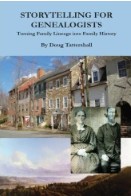
Every January, I set a new genealogy goal. This year, I challenged myself to transform decades of family research into engaging narratives—a goal as exciting as it was intimidating. I found myself wondering: Where should I begin? Should I start at my own story or dive into the farthest reaches of my ancestry, where brick walls often appear? How best to organize it all—by region, period, or perhaps by keeping different family lines separate? Once organized, what’s the ideal format: an eBook, a physical volume, or something entirely different?
I took the plunge in January and ended up self-publishing two family books. I’m now working on a third, with a fourth possibility on the horizon. Yet amid the progress, one thing lingers—I wished I'd discovered Doug Tattershall’s Storytelling for Genealogists – Turning Family Lineage into Family History sooner.
Doug’s book is a delightful, practical guide filled with creative ideas and actionable tips. With a background in journalism, he cuts straight to the heart of the matter: while meticulous research and accurate record-keeping are essential, they alone won’t preserve your family’s legacy. The true magic lies in writing compelling stories that breathe life into your ancestors. I especially appreciated his thoughtful examples for making people’s lives memorable and his sensitive approach to ethically sharing delicate family details.
For anyone feeling daunted by the prospect of writing family histories, Doug’s work is a must-read. By the end of this engaging and accessible book, you’ll not only gain confidence in your ability to craft captivating narratives, but you’ll also learn strategies that can help turn a mountain of research into a legacy that lives on for generations.
I do have one regret: I could have benefited immensely from the short planning guide included in the back of the book. It’s a reminder that just as we plan our research strategies—especially when confronting those stubborn brick walls—we should also plan our storytelling approach.
Whether your family’s memories are best captured on paper or through auditory storytelling, Doug offers creative ideas for every style. I’ve already recommended his book to several colleagues who had been hesitating to start their own writing journeys. If you’re ready to preserve your family history in a way that truly resonates, I encourage you to check out Doug Tattershall’s guide—available through Genealogical.com.

No comments:
Post a Comment